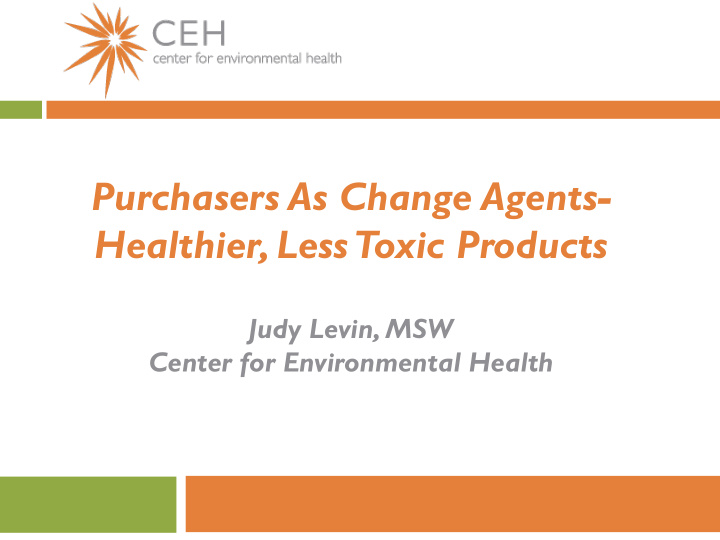



Purchasers As Change Agents- Healthier, Less Toxic Products Judy Levin, MSW Center for Environmental Health
Diseases Linked to Environmental Exposure on the Rise Asthma up 100% Brain cancer up 20% Impaired fertility doubled 1-in-6 with learning and developmental disabilities Leukemia up 20%
Chemical Policy in the US Most Chemicals in the U.S. are Not Regulated 62,000 chemicals “grandfathered in” EPA has regulated only five chemicals Only 200 chemicals have been tested for threats to human health and the environment 85% lack data on chemical health effects 2,000 new chemicals enter market each year
Six Classes Videos An innovative approach to reducing toxics VIEW and SHARE: www.SixClasses.org Healthier products, healthier people in four minutes!
Indoor Air Quality Most Americans spend up to • 90% of their time indoors Indoor air can have higher levels • of pollutants than outside levels Impacts health, comfort, well • being, and productivity •
Case Study: Healthier Furniture The “Hazardous Handful” VOC’s (including Formaldehyde) Antimicrobials PVC Fluorinated Stain Treatments Flame Retardants
Creating Healthy Interiors: Avoiding Chemicals of Concern Flame retardants: PVC: Formaldehyde: PFAS: Antimicrobials:
Chemical Flame Retardants Health Concerns: o Reproductive o Neurodevelopmental o Immune system impacts o Cancer Flame retardants migrate out of products: found in humans, breast milk, dust, pets, wildlife, environment Do not reduce number or severity of fires in typical furniture Recommendation: Specify products that do not contain FRs and are labeled as such.
Polyvinyl Chloride (PVC) / Vinyl Health Effects: • Neurodevelopmental, endocrine disruptor, birth defects, reproductive, cancer Environmental Impacts: Problematic throughout life cycle: manufacture, use and end-of-life Recommendation: Avoid products with PVC Small components exemption: > 1% of product by weight Photo courtesy of Perkins + Will
Volatile Organic Compounds Health Effects: • Respiratory, cancers, decreased fertility Environmental Impacts: • Negatively affects indoor air quality Exposure via inhalation, dermal, or • occupational Recommendations: • CA Section 01350 (CA Dept. of Public Health) or SCS Indoor Advantage Gold or Greenguard Gold Photo courtesy of Perkins+Will
Fluorinated Compounds (aka PFCs or PFAS) Health Impacts: Kidney and testicular cancer, thyroid disruption, elevated total cholesterol, obesity Environmental Impacts: Extremely persistent in environment and may bioaccumulate in people and wildlife Migrates out of products Exposed via ingestion of contaminated materials, food, (including breast milk) and occupational Recommendation: Avoid stain or water repellant treatments that contain PFAS
Antimicrobials Health Impacts: • Endocrine problems, reproductive changes and possible increased allergies in kids. Environmental Impacts: Limited evidence that antimicrobials added to furnishings reduces spread of infection Exposed through ingestion, inhalation and dermally Can create “super bugs” Recommendation: HCWH and Ted Schettler, MD, MPH, https://noharm-uscanada.org/sites/default/files/documents- files/3854/Antimicrobials%20Report%202016_1.pdf HBN and Perkins+Will, https://perkinswill.com/sites/default/files/Antimicrobial_WhitePaper_PerkinsWill.pdf Avoid products with antimicrobials Kaiser Permanent, Bulletin #201-05: Prohibition of Antimicrobial Chemicals in Fabrics, Furniture, and Finishes Understand marketing claims
Consider “End of Life” Extend Product Life When Possible Redeploy Reupholster/ Refurbish/ Remanufacture Extending Life Has Other Benefits: Energy Savings Waste to Energy/Landfill Avoidance CO 2 Reduction Natural Resource Savings Zero Waste Reduction Goal
Healthier Furniture : “Low Hanging Fruit ” Healthier People and Communities Market is Receptive Safer Alternatives Exist Cost Neutral or Cost Savings * Sustainability success story Aligns with organizational mission and values Can contribute to valuable LEED points CEH offering technical assistance and resources * Hackensack University Medical Center saved $65,000 on a $250,000 spend for lounge furniture
Existing Ecolabels/ Standards For Furniture
ANSI/BIFMA e3-2018 Updated Furniture Sustainability Standard Credit 7.4.4: Targeted Chemical Elimination New criterion restricts: Flame retardants PFASs Antimicrobials PVC Formaldehyde Can apply to level 1, 2, or 3 products Specify Products That Meet 7.4.4
Manufacturers with Products Free of the Key Chemicals of Concern (partial list)
Considerations for EPP Foodware for Reusable Compostable Recyclable Examples of Additional Environmental Attributes: Recycled content Forest Stewardship Council (FSC) Certified Chlorine-free bleaching
Disposable Foodware & Fluorinated Additives Can end up in food and landfill/compost Minimize use of disposables; use reusables whenever possible. Compostable does not equal safe (BPI-certified or Cedar-Grove Accepted “compostable” products can still have PFAS) https://www.ceh.org/ceh-report-avoiding-hidden- hazards-purchasers-guide-safer-foodware/
Summary of Test Results by Product Material Type • Plates, bowls, clamshell containers and food trays • ALL MOLDED FIBER products tested had high fluorine content
Moving the Market T oward Safer Products Test the market with RFIs (if needed) Build specifications into RFPs/ contracts Identify healthier products and block non-EP products Piggyback on “green” cooperative buying agreements Use contract extensions as opportunity for change Photo courtesy of Perkins+Will
Summary: Ways CEH Can Help Educate key staff (webinars, trainings) Participate in product testing (foodware) Provide sample letters to suppliers Survey manufacturers (if needed) Help interpret manufacturer responses Provide Tech. Specs. for RFPs/RFIs/Contracts Provide technical assistance
Carpeting and Flooring Carpeting: San Francisco Specification Available https://sfenvironment.org/sites/default/files/policy/regulation_sfe- 2018-01-ppo_gbrcbo.pdf Or https://bit.ly/2K4e3kZ Resilient Flooring: Guidelines Upcoming
CEH Resources Food and Foodware Furniture https://www.ceh.org/campaigns/endocrine https://www.ceh.org/campaigns/flame- -disrupting-chemicals/edc-resources/ retardants/resources/
Purchasers’ Voices Move the Market Provide reasonable timelines for supplier conformance Be willing to consider new suppliers if needed Incentivize manufacturers who step forward Market demand can influence the market faster than regulations or legislation
Contact Food and Built Environment Foodware Center for Environmental Center for Environmental Health Health Sue Chiang, MPH, MPP Judy Levin, MSW (510) 740-9391 (510) 594-9874 sue@ceh.org judy@ceh.org
Recommend
More recommend